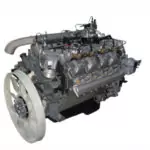The 2.2L Duratorq-TDCi engine is a four-cylinder, in-line, turbocharged diesel engine with two camshafts, 16 valves, a balancer shaft block for optimum smoothness, an exhaust gas recirculation (EGR) system.
The cylinder block is made of cast iron, with cast cylinder liners and double-walled for high strength. In addition, an air jacket has been additionally created, which significantly improves sound insulation. The cylinder mirrors are bored directly into the cylinder block. To fix the head gasket, two holes for guide bushings are made in the cylinder block.
The cylinder head is composite, aluminum, and consists of two parts. The lower part of the cylinder head is attached to the cylinder block with ten bolts. Re-use of bolts is not allowed as they have a programmed tightening deformation.
Specifications
| Manufacturer | Ford |
| Also called | Duratorq 2.2 |
| Fuel system | direct injection |
| Configuration | inline |
| Number of cylinders | 4 |
| Piston stroke, mm | 94,6 |
| Cylinder bore, mm | 86 |
| Compression ratio | 17.5 |
| Displacement, cc | 2198 |
| Power output, hp | 85 – 130 / 3500 |
| Torque output, Nm / rpm | 250/1500-2200 – 310/1100 |
| Fuel type | diesel |
| Euro standards | Euro 4 |
| Firing order | 1-3-4-2 |
| Engine lifespan, thousand km — official information |
300 |
Duratorq 2.2 Engine Diagram
- Timing belt;
- Fuel injection manifold;
- Electronically controlled intake manifold flap;
- Vacuum pump;
- Fuel pump;
- Electrically controlled exhaust gas recirculation (EGR) system;
- EGR cooler;
- Turbocharger guide vane adjuster;
- Variable nozzle turbocharger;
- oil sump extension;
- Fuel filter;
- Oil filter / oil cooler unit;
- Crankshaft damper.
Duratorq engines include 16-valve TDCi units with advanced Common Rail fuel delivery and a common fuel rail. These powerplants deliver decent torque across virtually the entire operating range, contributing to Ford Transit’s excellent payload of 1.4 tonnes. The motors of the family are distinguished by quiet, smooth operation with minimized noise and vibration levels. Diesel engines were made according to the classic scheme: a cast iron cylinder block and an aluminum head. There are four valves per cylinder. Also, subsequently, Ford engineers improved the ventilation system, which excludes possible engine overheating.
Duratorq 2.2 is designed with advanced technology and a high pressure manifold mounted on the intake. The power unit meets all environmental requirements. In 2008, a special particulate filter was installed to meet the requirements of Duratorq diesels above the Euro-4 standard. An innovative approach to the design of powertrains has allowed Ford to bring its developments to near perfection. The Duratorq 2.2 motor is not only economical, flexible and smooth in operation, but also resource-intensive.
According to unofficial data, the life of diesel engines is 300 thousand kilometers. The manufacturer itself does not comment on this. The practice of operating Ford Transit shows that the figure of 300 thousand kilometers, obeying a van, is a kind of minimum. The version of the car with a 2.2L EcoBoost gasoline engine is capable of traveling 350 thousand kilometers before the first major repair.







